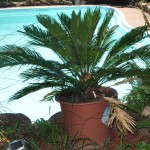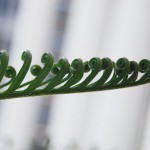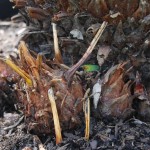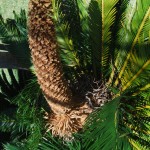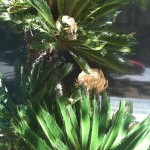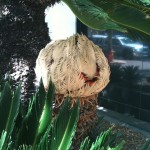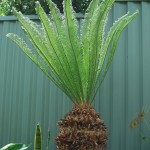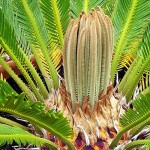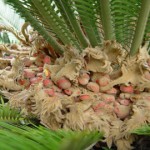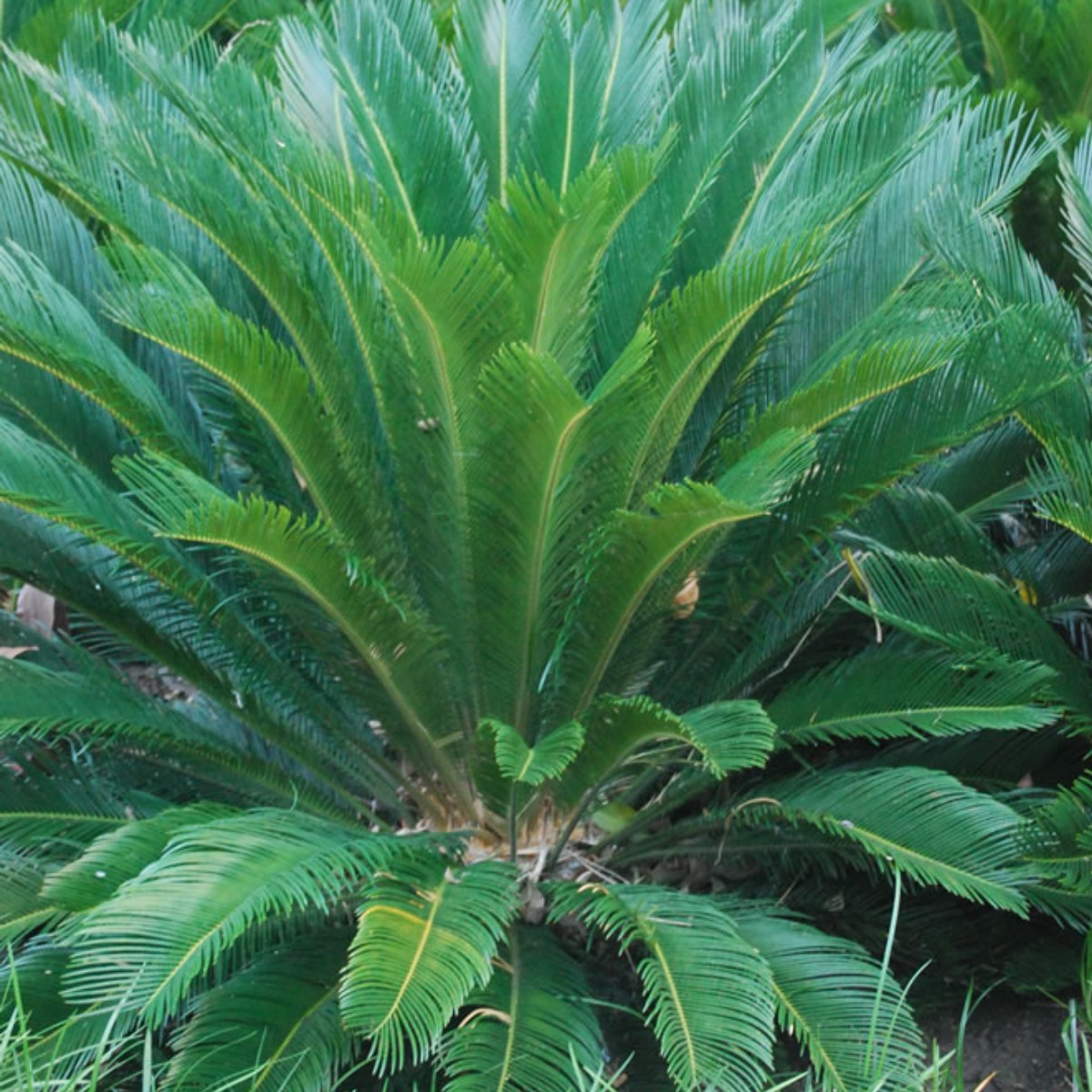Family: Cycadaceae
Distribution and habitat: Cycas revoluta is a species of gymnosperm in the family Cycadaceae, native to southern Japan. It is found in thickets on hillsides, usually between 100 and 500m (330-1650 feet) altitude.
Cycas revoluta is one of the oldest cycads and most primitive of plant families still living today, an ancient plant which dates back to 200 million years ago (the age of dinosaurs). It grows up to 100 years and is semi-tropical plant related to conifers, but looking like a palm.
Description: Cycas revoluta belongs to a group of plants palm-like which are among the most primitive of flowering plants. This species is slow-growing. The leaves, which are feathery-looking but quite stiff and hard, are arranged in a loose rosette. Each leaf is up to 90cm (35 inch) long and is borne on a short-spined, four-angled stalk 8-10cm (3-4 inch) long. The big leaf is itself divided into many 8-15cm (3-6 inch) long, needle-like leaflets, which are arranged in closely packed chevron-fashion on a central rib. Some of the leaves stand almost vertical, but most of them arch outward. They rise from the dome of oddly shaped, rather pineapple-like base with rusty, felted covering. This base, which sits on top of the potting mixture, contains a reserve of water upon which the plant can draw in case of dry conditions. Flowers do not develop on plants that are grown indoors.
The flowers are dioecious (individual flowers are either male or female, but only one sex is to be found on any one plant so both male and female plants must be grown if seed is required) and are pollinated by insects and wind. The female inflorescence is feather like, later forming a tightly packed seed head. The male cone is pineapple shaped.
Houseplant: Cycas revoluta is a very slow growing. When grown as potted specimens, Cycas revoluta may add only one set of new leaves every year or two and no much visible growth. Because of its slow rate of growth, it is also quite popular as a bonsai plant.
Over many years Cycas revoluta develops a substantial trunk and is a long-lived plant. Fifty-plus year-old plants are not uncommon for this species.
Pruning can be done anytime to remove dead fronds.
This plant has sharp needle-like leaflets, use caution when handling it.
Light: In order to produce leaves, Cycas revoluta must be given bright light all year long, with or without direct sunlight (it will do equally well either way). Do not attempt to grow the plant in medium or poor light as it will not thrive in such conditions.
The leaves can bleach somewhat if moved from indoors to full sun outdoors. Slowly accommodate the plant to the outdoor sun by place it in shaded position for the first two weeks.
Temperature: Normal room temperatures are suitable. These plants, however, are extremelly tolerant of apparently adverse temperature and atmosferic conditions. They can tolerate relatively low humidity and they are not harmed by temperatures falling as low as 13C (55F).
Water: During the active growth period (which is virtually all year) water these plants moderately, enough to make the mixture moist throughout at each watering and allowing the top centimetre (0.4 inch) or so of the mixture to dry out before watering again. During any rest period that may occur - possibly because of inadequate winter light - give the Cycas revoluta only enough water to prevent the potting mixture from drying out completely.
Feeding: Apply a liquid fertiliser about once a month from early spring until early autumn.
Potting and repotting: Use a soilbased potting mixture with the addition of a one-third portion of coarse sand or a substance such as perlite for extra drainage. Move these plants on to pots one size larger only when repotting is needed - roughly, when the pineapple-like base of the plant covers about two-thirds of the entire surface of the potting mixture. Repotting should not be necessary more often than about once in every two or three years.
Gardening: Cycas revoluta is a very hardy plant, tolerating dry periods and light frosts. It is heavily promoted commercially as a landscape plant. If the climate is not characterised by frosty winters, then growing aCycas revoluta in the ground is certainly an option. Obviously palms that grow in the ground have less maintenance requirements and can grow much taller than pot-bound specimens.
Pruning leaves should be done at least once a year. Oldest and lowest leaves eventually have brown tips or turn brown (to allow the plant energy to go to growing new leaves) and should be removed. Cut as close to the trunk as possible.
Position: Cycas revoluta grows well in full sun or light shade. While it will grow in shade and perform quite well in part-shade it can often become leggy and more disease-prone without at least half a day of full-sun.
Soil: It grows best in sandy, well-drained soil, preferably with some organic matter, although these durable plants seem to grow in almost anything. However, it needs good drainage or it will rot.
Plant Cycas revoluta slightly above the soil line and not in a hole or depression which retains water or is swampy. They much prefer to be on the dry than the wet side.
Irrigation: . If planted in the garden, water when dry, but do not keep continuously wet.
Established plants are fairly drought-tolerant.
Fertilising: Fertiliser is generally applied during spring and late summer. Too little plant food is far better than too much. If organic or slow release fertilizer is used, do not allow any to fall into the plant crown which is protecting the formation of future leaves.
Propagation: Cycas revoluta are propagated commercially from seed. This type of propagation is particulary slow process with these plants, however. Most indoor gardening experts agree that it is not feasible for the home gardener.
Mature plants grow sometimes offsets - called pups - that can be separated and planted into their own containers.
Problems:
Cycas revolutaproblems are usually related to watering. Yellowing leaves are often caused by overwatering. Follow the watering instructions to avoid crown rot. It is almost impossible to treat and plants may not recover.
Scale insects are the most common pest.
Treatment: Look over the plant often for scale and treat any infestation immediately with insecticide.
Notes: Cycads were the first seed plants on earth.
Cycadales are one of the four major groups of gymnosperms and are the most primitive extant gymnosperm order. This ancient Cycads family (Zamiaceae), are known to have lived in the Pangaea, and Permian era, over 200 million years ago - even before the dinosaurs roamed the earth. The Age of Cycads, began during the Triassic Period of the earth's geological history reached its peak during the 60 million years of the Jurassic Period and ended during the Cretaceous Period, about 95 million years ago. There are 9 groupings of cycads: Bowenia, Cerotozamia, Cycas, Dioon, Encephalartos, Macrozamia, Microcycas, Stangeria, and Zamia. There are about 300 species of cycads.
Cycads are dioecious (meaning that male and female reproductive structures are borne on separate plants). Though classified as woody plants, they have a pachycaul stem, a thick, soft stem or trunk made up of storage tissue with very little true wood. The cycads have been classified as 'gymnosperms' however recent studies suggest some members are closer to the flowering plants than to other 'gymnosperms'.
The Cycadales and Ginkgoales are unique among seed plants in having motile sperm. The mature seeds are dispersed by both birds and squirrels, which eat the fleshy outer coating, but not the seed itself.
Uses: Beautiful specimens can be grown in pots and urns and they can look extremely elegant when used as visual enticing entrance plants.
It has a beautiful prehistoric look and works superbly as a statement plant in garden beds or as an under planting in subtropical and modern landscapes. Cycas revoluta is a plant that works beautifully in drought resistant garden designs.
Toxicity: All parts of this plant are poisonous, especially the seeds. Keep it out of the reach of children and pets that may play with or ingest this plant.
SUMMARY:
CHARACTERISTICS:
Foliage green
Shape rosette
Height: 3.5-5m (11-16 feet)
Spread: 2.5-3m (8-10 feet)
PROPER CARE:
Watering in rest period sparingly
Watering in active growth period moderately
Light bright
Temperature in rest period min 13C max 24C (55-75F)
Temperature in active growth period min 16C max 24C (61-75F)
Humidity low
Hardiness zones: 8b-11
